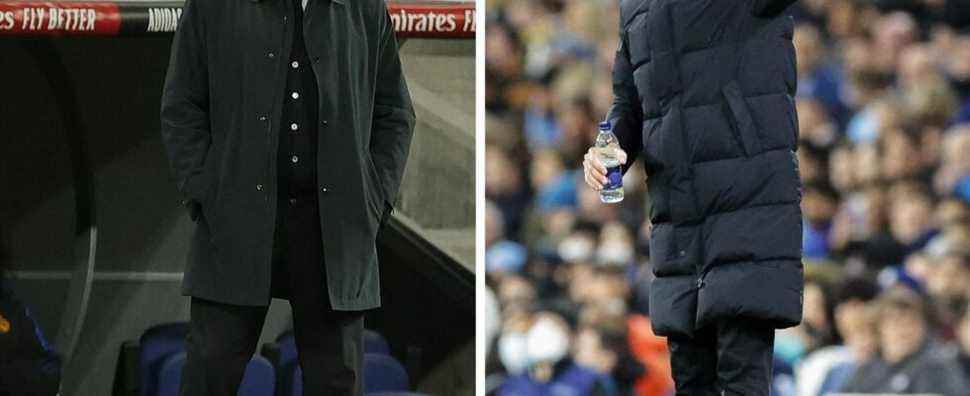A duel on the field, but also on the benches. The first semi-final of the Champions League sees Pep Guardiola’s Manchester City and Carlo Ancelotti’s Real Madrid face off on Tuesday, April 26, at the Etihad Stadium. Two of the greatest coaches currently in activity, both former players who chose the path of the bench at the end of their sports career, have been side by side for several seasons on the European scene.
A level where they both shone. Guardiola (51) won two Champions Leagues with Barça, in 2009 and 2011, and has been running for more than 10 years after another star-studded success. Carlo Ancelotti (62) lifted the cup with big ears three times, first with Milan, in 2003 and 2007, then with Real Madrid in 2014. But in style and management, almost everything separates them.
Style of play: Guardiola the dogmatic, Ancelotti the chameleon
Pep Guardiola is an obsession. Since his first steps on the bench in 2008, he swears by possession and conservation. Heir to the “tiki-taka” dear to Johan Cruyff, the Catalan has made it a rule, a dogma.
All the locker rooms he went through had to adapt to the triptych of possession, long passing sequences, and high pressing when the ball was lost. Manchester City is no exception. Since the arrival of the technician in the summer of 2016, the Cityzens have transformed to become a conservation and distribution machine. On the European scene this season, they have the most confiscatory possession (60.4% on average) since the start of the competition.
Real Madrid 2-3 Chelsea = a #UCL classic!
Best moment at the Bernabéu?— UEFA Champions League (@ChampionsLeague) April 15, 2022
In front, Carlo Ancelotti has shone throughout his career as a technician by his ability to adapt. Pragmatic, the Italian adapts to his team, and can also adapt it in return to his opponent, or on occasion. The double confrontation in the round of 16 against the PSG, in February, is a recent example. On the first leg, he almost made the perfect move by asking his men to defend for 90 minutes to hold the draw, before they were struck down in added time by Kylian Mbappe. Three weeks later, in the return match, the people of Madrid set a more attacking pace throughout the game to overthrow the Parisians and clinch their qualification.
Locker room management: Guardiola eruptive tactician, Ancelotti quiet manager
The style of the two men also differs in their management. Even in the management of his group, Pep Guardiola remains above all a tactician. He continually seeks to distill his ideas as well as possible with his group, which has sometimes earned him criticism, especially at Bayern, where his style of play was not always appreciated by the leaders and certain managers of his team. The Catalan also has an explosive temperament, and does not hesitate to be expansive on his bench, but also outside. On the sidelines of his Barça’s 2011 Champions League semi-final against Real de Mourinho, he described the Portuguese as a “damn… chief, damn… master”good at putting on a show at a press conference.
Conversely, for almost thirty years that he has been coaching, Carlo Ancelotti has built the reputation of a real locker room manager. In his various clubs, the Italian had to learn to manage individuals and strong personalities (Cristiano Ronaldo during his first spell at Real, Zlatan Ibrahimovic at PSG, etc.) and attaches great importance to human ties within his group. More discreet and reserved than his counterpart, the Italian is more adept at working in the shadows, and flees the light a little more. “He is always very relaxed, it is good for the team”praised his captain at Bayern Philipp Lahm a few weeks after the arrival of the technician in Bavaria.
The course: Guardiola over time, Ancelotti on the move
Pep Guardiola and Carlo Ancelotti have had radically different club careers. In 14 years of coaching activity, the first has only managed three clubs, where the second found himself at the head of ten different teams during his 27 years of practice. With Barça, Bayern and Manchester City, Pep Guardiola has only known clubs with gigantic financial means, which he has accompanied over time (three seasons in Germany, four in Catalonia, he is completing his sixth year in Manchester) . Leaving after completing his contract with Barcelona and Munich, he left good memories at both clubs.
#ManCity | https://t.co/SJnW6B3eXk pic.twitter.com/F4nQFKb6vC
— Manchester City (@ManCityFra) April 22, 2022
Carlo Ancelotti’s professional life is more eventful. With the exception of his eight years on the AC Milan bench between 2001 and 2009, his terms have often been short, the time of one or two seasons. After having started in Italy, he traveled to the rest of Europe, in leading clubs, in London (Chelsea), Paris, Madrid or even Munich, where he succeeded his opponent of the day in the summer of 2016. In recent years, the Italian has also accepted challenges in more modest clubs, in Naples and then Everton. By taking over the reins of Real Madrid last summer, from where he had been sacked in May 2015, he found himself for the first time in his career at a club where he had already passed.
